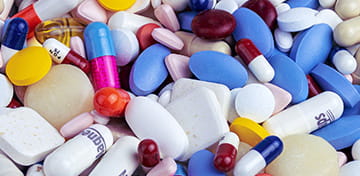Lance Armstrong’s cancer battle started in 1995, and it took two long years of worry and pain, but against all odds, the bicyclist was able to make a full recovery. Read along to learn more, and feel free to use the navigation panel below to jump to a relevant section of the blog post.
Who Is Lance Armstrong – How He Earned the Spotlight
Lance Edward Armstrong is a former American road cyclist, who gained fame after winning the Tour de France competition seven times, from 1995 to 2005. However, a doping scandal forced his career to come to an abrupt end.
He began his training at age 16 so he could become a national champion in triathlete, with several wins from 1989 and 1990. He started as a professional cyclist with the Motorola team, and had great success between 1993 and 1996, winning the Clasica de San Sebastion championship in 1993.
However, his career was met with an abrupt end, caused by a doping scandal, and an intense battle with testicular cancer, which we will cover in detail further in the post. The medical professionals claimed there was no hope, but Lance Armstrong, the cancer survivor, recovered and went on with his family life.
Even though Lance Armstrong no longer participates in races, and players who place wagers at the best cycling betting sites in the UK can no longer support him with a bet, his story still inspired many and is one to surely be remembered.
Cancer Diagnosis and the Start of the Battle
Lance Armstrong’s cancer fight began on October 2, 1996, when he was only 25 years old. Medical professionals diagnosed the cyclist with stage three testicular cancer, meaning that the disease was in its advanced state.
Tumors and growth have spread all over Lance’s body, including the lymph nodes, his lungs, brain, and abdomen. Urologist Jim Reeves in Austin, Texas, was able to place the diagnosis due to Lance’s symptoms – blurred vision, coughing up blood, and especially, a swollen testicle.

Lance had always thought that he had something wrong with one of his testicles, even before the diagnosis.
He noted that it was abnormally large, and caused him immense, frequent searing pain. But when he started coughing up blood, he sought serious professional help.
So, on October 2, 1996, Lance Armstrong’s cancer fight began, and it wasn’t looking good. Further on in the blog we will cover how the cyclist was treated, chances of survival, severity of the situation, and more.
The Treatment Process of Lance Armstrong
The immediate response by medical professionals was to perform an orchiectomy – a removal of the cancerous testicle. Armstrong was then transported to Indiana University for the remainder of his treatment.
Lance was administered with many healing drugs, including bleomycin, etoposide, and many more, for his first chemotherapy cycle. Unfortunately, Armstrong had an allergic reaction to one of the drugs, and medical professionals needed to find an alternative, which, thankfully, did its job.
Expectedly, the question regarding Lance Armstrong’s cancer research popped up – what are my chances of survival? That’s when the cycling champion learned that his odds of survival were slim to none. The response by medical professionals was staggering – “Almost none. 50%, at most, but 20% realistically”

Against all odds, Armstrong responded extremely well to the treatment.
He had his final chemotherapy on December 13, 1996, and just a month later, was able to ride 100 kilometers with his new teammates, returning to the United States. We cover his recovery in detail later.
For your convenience, we have included a timeline of Lance’s treatment. You’ll find the events below.
| Date | Event |
|---|---|
| October 2, 1996 | Diagnosis with Stage Three Testicular Cancer |
| October 3, 1996 | Testicle Removed via Orchiectomy |
| October 25, 1996 | Removal of Brain Lesions |
| December 13, 1996 | Final Chemotherapy |
| January 1997 | First Race of 100KM After the Incident |
| February 1997 | Lance Armstrong Became a Cancer Survivor |
The Severity of Testicular Cancer
We will briefly cover how dangerous testicular cancer can be, to emphasize how amazing Lance Armstrong’s recovery from cancer is. This type of cancer is rare – it affects 4 out of every 100,000 men, and accounts for 1 or two percent of all male cancers. However, it is still the second most common cancer, behind leukemia.
Lance Armstrong’s cancer was tough, and his recovery was a miracle. Stage three means that the cancer has spread to the lymph nodes and other organs, meaning that a simple removal of the diseased testicle is not enough.
Even though chances of survival were low, the tremendous help of the medical professionals treating Lance proves that even the most severe cases of testicular cancer can be cured, and Lance is a prime example of that.
Lance’s Survival and Complete Recovery
As we mentioned, Lance Armstrong’s recovery from cancer wasn’t easy, but ultimately, it happened. Doctors weren’t optimistic, as chances of survival were extremely low, but Lance pulled through. Armstrong simply refused to lose to this cancer, and willpower along with extensive medical care was all that it took.
According to Lance, knowledge means that you never had to face the enemy alone. Armstrong stood up all night, researching info regarding his condition through books and the internet. Meeting other patients in treatment groups gave him further strength and courage.
Eventually, even though the odds were low, doctors knew that Lance’s body was different. He was an athlete and a world champion. They claimed that such physique and willpower were one in a million. Chemotherapy was also going extremely well, according to medical professionals.

The cyclist did not want to lose. He had a great career ahead of him. Lance Armstrong will be a cancer survivor, is all he thought about, and he was able to achieve that goal.
However, his career would take a turn for the worst, because the sports professional was involved in a huge doping scandal.
A major doping investigation regarding him took place, which eventually led to the American racing cyclist’s retirement. We’ll cover this in detail in the next section.
Lance Armstrong’s Doping Scandal
Lance Armstrong’s recovery from cancer was surely a major victory in his life. Even though everyone thought his career was over, the athlete proved them wrong. But it turns out that his days of being a world champion will end in a different manner.
Lance Armstrong faced multiple, persistent allegations of doping, but until 2006, there was no official undertaken investigation. His sixth consecutive Tour de France win was met with suspicion. After that, SCA president Bob Hamman read L.A Confidential, a book by cycling journalists, and SCA had to pay a bonus of 5 million dollars to Armstrong.

However, Hamman’s real goal was to force an investigation by authorities to prove that Armstrong was doped and strip him of his Tour de France victories.
Eventually, his hunch proved correct, and the US Anti-Doping Agency (USADA) reviewed Hamman’s evidence, proving it to be plausible.
U.S. federal prosecutors were investigating allegations of doping by Armstrong from 2010 to 2012 and ultimately were able to prove him guilty. Lance was stripped of all his results and prizes from August 1, 1998, which include all seven Tour de France titles and an Olympic medal. See the list below for additional info.
- 1996 – La Fleche Wallonne, and second Tour DuPont win.
- 1997 – Battle with cancer
- 2000 – Second Tour de France win
- 2001 – Third, consecutive Tour de France win
- 2002/2003 – Fourth and fifth Tour de France wins
- 2010/2012 – Doping allegations and suspicions
- 2013 – Armstrong finally admits to doping, and retires
These events marked the end of Lance Armstrong’s cycling career. After being stripped of his titles, he now owns a media company, living in his hometown of Austin, Texas.
In conclusion, Lance Armstrong’s intense cancer battle was understandably the most difficult moment of his life, but with all the intensive medical care by the professionals and his strong will, he managed to recover.
We cannot forget to mention the doping scandal, as this was the next obstacle Armstrong needed to overcome. At least he came out clean, admitted to utilising unapproved methods, and can now stay with a clear conscious and live his life.
Frequently Asked Questions
In the section below, you’ll find quick answers to the segments discussed in the blog. We covered a lot, and the most common inquiries are below – you can click on the links that will take you to the relevant section of the blog post.
- SEO Powered Content & PR Distribution. Get Amplified Today.
- PlatoData.Network Vertical Generative Ai. Empower Yourself. Access Here.
- PlatoAiStream. Web3 Intelligence. Knowledge Amplified. Access Here.
- PlatoESG. Carbon, CleanTech, Energy, Environment, Solar, Waste Management. Access Here.
- PlatoHealth. Biotech and Clinical Trials Intelligence. Access Here.
- Source: https://www.bestcasinosites.net/blog/lance-armstrong-cancer.php



